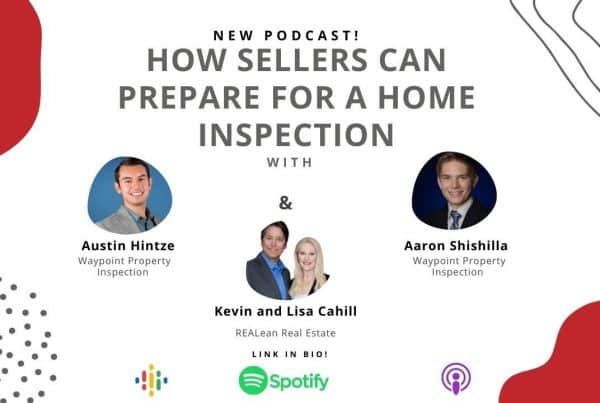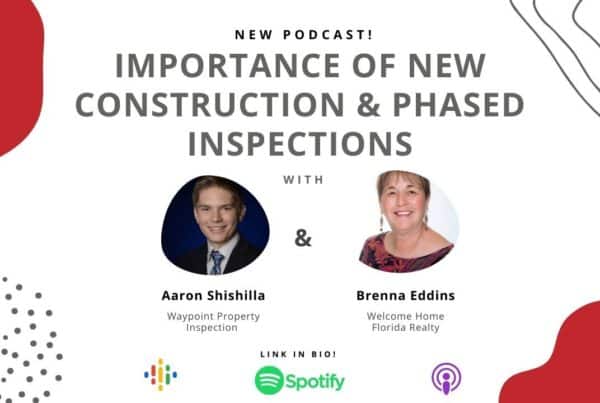
On this episode of Waypoint Real Talk, Francis from Marketing For Change shares her research on homebuyers wanting sewer scope inspections and why they need them.
Listen To The Full Podcast
[powerpress]Read The Blog
Home inspectors know better than anyone that the house of a buyer’s dreams can have costly hidden surprises. One of them that can often get overlooked is a home’s lateral sewer line.
As pipes get older they can break down or roots can grow in and intrude on the pipe. When this occurs, waste and chemicals can leach out, and rainwater can seep get in and overwhelm the pipe — leading to overflows during rain events. These breaks not only cause plumbing backups for homeowners, but also lead to nutrient pollution leaking into our Central Florida waterways.
Problem laterals are most common in homes built before 1975 — prior to the use of PVC piping. In the 1950s & 1960s they commonly used Orangeburg pipe — a wood pulp and pitch mixture — and cast iron pipes, which can degrade over time.
As local governments are working to improve aging public sanitary sewer systems, efforts are also underway to encourage the update of privately owned laterals, which also play a role in affecting water quality in Tampa Bay and its watershed.
Last summer, the Tampa Bay Estuary program enlisted Marketing for Change, a national behavior change communications agency, to conduct qualitative research and develop a marketing campaign to foster action by homeowners to replace or repair their privately owned lateral sewer lines to improve water quality in Tampa Bay and its watershed. We conducted online discussion groups with adults who lived in Tampa, Plant City, Temple Terrace or Pinellas County and owned a home built before 1970. Separately, we conducted in-depth interviews with utility experts, plumbers, realtors, and home inspectors.
Here are the top 4 things we learned that you should know from our research:
- Most homeowners don’t know what a lateral sewer line is.
At the start of the study, most homeowners didn’t know what a lateral sewer line is, where it is located or that it’s their responsibility to maintain it.
- Homeowners assume lateral sewer line inspections are included in standard home inspections.
While some participants generally knew old pipes should be inspected, many assumed this would be automatically part of the required inspection when they buy their home. Once they learned lateral sewer lines were not included as a standard part of their required home inspection, some prospective homeowners expressed feeling motivated to take proactive action by asking for a lateral line inspection to be included in the overall home inspection to give them peace of mind.
- Issues with a lateral sewer line are something prospective homebuyers want to know about.
Learning that a damaged line could result in a very costly repair increased participants’ interest in having the sewer line inspected before purchasing a home.
Once they purchase the home, homeowners in general take an “out of sight, out of mind” approach to their sewer lines, waiting until there is an obvious plumbing problem, like a sewage back up, before shelling out the money for a repair. This makes the pre-purchase home inspection the ideal time for potential buyers to inspect the lines so they can make an informed decision on their purchase or in negotiations.
- Home inspectors are viewed as a trusted resource for homeowners.
Home inspectors were viewed very positively by the homeowners and homebuyers in the discussion group because they are thought to be objective, unbiased sources of information and expertise. Participants said they would be most likely to trust a home inspector’s recommendation to get a lateral sewer line inspection (compared to other relevant experts).
What can you do as a home inspector?
As a trusted expert resource for prospective home buyers, home inspectors have a unique and important role to play in encouraging the update of outdated and damaged lateral sewer lines. Here are a few things you can do:
- Provide camera scoping as an add-on service for potential buyers of older homes. This could either be through partnerships with contractors who offer scoping services or investment in the equipment to perform the inspections yourself. This would not only increase client satisfaction by making them feel more confident in their home buying process, but will also allow for an opportunity to make additional profit through the new service.
- Provide information to clients about rebate programs for scoping inspections if or when they are offered. As part of municipalities’ efforts to encourage lateral line inspections, some are considering offering a rebate to offset the cost of inspections and/or replacements.
- Work with realtors to create a checklist for “vintage” home buyers so prospective buyers are made aware about special considerations they should know about when buying an older home, including scoping of the lateral sewer line.
Final Thoughts
As part of our work with the Tampa Bay Estuary Program, we’ve partnered with them to launch Pipe Up — a new website to help homeowners and prospective buyers understand more about their lateral line and how to get it inspected. As part of it, there’s a portal just for home inspectors at TBEP.org/PipeUp/Inspector with resources and information to help you guide prospective homebuyers around lateral sewer line inspections.
This was a guest post written by Francis Diaz Kennedy from Marketing For Change.



